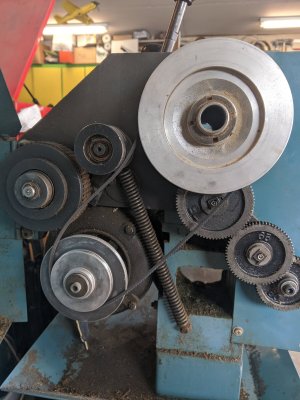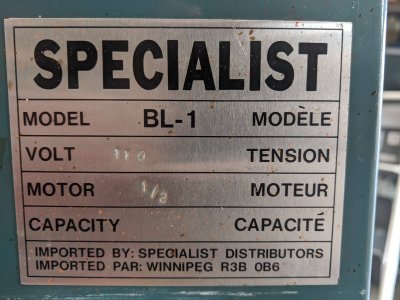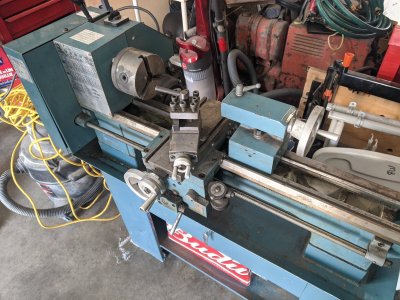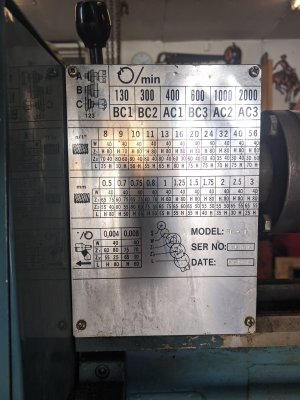Having some dimensions would be helpful, maximum swing diameter, distance between centers as examples. But it's probably either a 8" -9" swing lathe. These were originally cloned from the 8" swing Emco Austrian made lathes.
http://www.lathes.co.uk/emcocompact8/ I'm unsure if the user manuals on the grizzly website go back far enough. But at one time they did sell a very close copy of what you have. If there's a tag still on your motor it might indicate it's country of origin, very likely that will be either Taiwan or China. A word of advise, the less you know the more careful you'll need to be for your own safety and for preventing machine damage. If it were me? It's pretty easy to see that lathe has been neglected and likely misused at least a bit. I'd start with a complete and thorough detail cleaning. I'd bet that 3 jaw chuck has never been cleaned since new and it's likely a bit stiff with chips and old congealed oil. Carefully disassemble it and especially mark the chuck pinions and holes for them on the chuck body so your sure everything goes back into where each part came from. If the chuck was well made, the jaws tips were ground after it's first assembly. So each pinions location helps to preserve any accuracy the factory built into it. My Emco heavy duty chucks are quite specific in the user instructions about those pinion locations when disassembling the chucks. One way to tell if that is a well made chuck, look for a O mark at one of the chuck pinions, that's what is normally referred to as the master pinion, and it was the one used to tighten the chuck to then grind the jaw tips for concentricity. If it does have that O mark then that's the pinion that should be used for the best concentricty when tightening the chuck each time.Some insist on using grease to lube a chuck, but it traps those metal chips inside. I've found even way oil to work well enough although you will get a bit of spray out of the chuck the first time it's run up to a higher speed. And pulling chucks apart for that cleaning and re-lubrication is a standard maintenance item at least every year or two or more often if you can feel the chuck starting to bind up with chips inside. Through drilling and boring parts is what causes most of the issue since centrifugal forces as the chucks spinning helps to drag those chips into the chucks internals.
Disassemble the tail stock completely and be sure to spotlessly clean it's Morse Taper bore, and if you wouldn't actually eat off the tooling your inserting into that bore it's not clean enough to be using it. A damaged tail stock bore is an expensive and very tough to properly fix problem that's easy to not have happen in the first place. Even free MT drills and tooling shanks with rust on them are far too expensive for any lathe I own. MT tool shanks and the female tapers they fit into are a high precision item. On a lathe tail stock without a draw bar, they can only hold due to there wedging effect and the high friction between both surfaces. Both of those depend on that high precision fit. Again lube the tail stocks internals and screw with either a light single weight non detergent motor or way oil. Then do the same to the top and cross slide. A clean and well lubed slide is far easier to accurately adjust and it will allow more repeatable settings to be made. For future reference, any discolored dark or black oil on a machine tool is that color because it's full of wear particles and contamination. If your oil is discolored your not using enough nor adding that lubrication often enough. Lubrication is the cheapest preventative maintenance you can do. Far more machines get worn out from poor or incorrect lubrication practices than ever get worn out from actually machining metal. And grease is almost never used despite what some might think on machine tools today for one very logical reason. It as I mentioned traps those cutting chips, dirt and wear contamination. Oil helps to most times flush that out. I see many on Youtube using either motorcycle chain lube or grease on there change gears. Compared to the gearing in any vehicle transmission, those lathe change gears on machines of this size see very low actual torque loads. A few drops of oil on each gear each time you use the machine is ample. Any oil is better than no oil, and I've tried in the past just about everything until I did finally try a proper way oil. It makes enough of a difference it's worth doing what you have to getting some. Mobil Vactra no. 2 is one I know that works well.
Grease is and does get used today on a large percentage of cnc machines. But there designed and well guarded to use that type of lubrication. And most of those use some type of built in timed auto lube system. Grease explained simply is made from oil with a carrier agent used to transmit it into the areas being greased. On machines not designed to use it, grease will greatly accelerate wear over regular light applications of oil. Second guessing my lathe manufacturer's lube recommendations cost me an $800 motor a number of years ago. Today I use exactly what they think is best and not what I do.

An extra tip. If your ever turning cast iron castings or steel with ANY exterior rust on it, then to start with, wire brush as much of that rust off away from your lathe first. Then cover the lathe ways, cross and top slides with clean cloths until you get the first pass made and the part surface is down to clean metal. The crust on castings is both extremely hard and full of casting sand, but rust is also a rudimentary form of iron carbides. Both of those are much harder than the metal that lathe is made of. That material can and will embed into the softer material of your slide surfaces. When it does and with the usual lube oil it will act exactly like a lap to vastly increase your wear rates. Covering your lead screw is also a good idea as well.
I would imagine after you've used that lathe for awhile you'll be back with more questions for leveling it and adjusting the tail stock so it's center line is true to the head stocks C/L. Both are important and both if incorrect result in unwanted part tapers. Before those questions, buy if you don't already have them a good 6" dial or digital caliper, a good 1" capacity micrometer with .0001" divisions, and a cheaper off shore magnetic base and 1" dial indicator with .001" divisions on the dial. Optional maybe, but I'd still recommend one, a .0001" reading lever type dial test indicator. Depending on how far you want to go and what you can afford? A level of at least this accuracy
https://www.grizzly.com/products/grizzly-master-machinist-s-level-8-x-0005-per-10/h2682 might be non optional as well. How well and permanent any leveling adjustments are will be directly related to what your bench and floor surfaces are made from.
Pete





